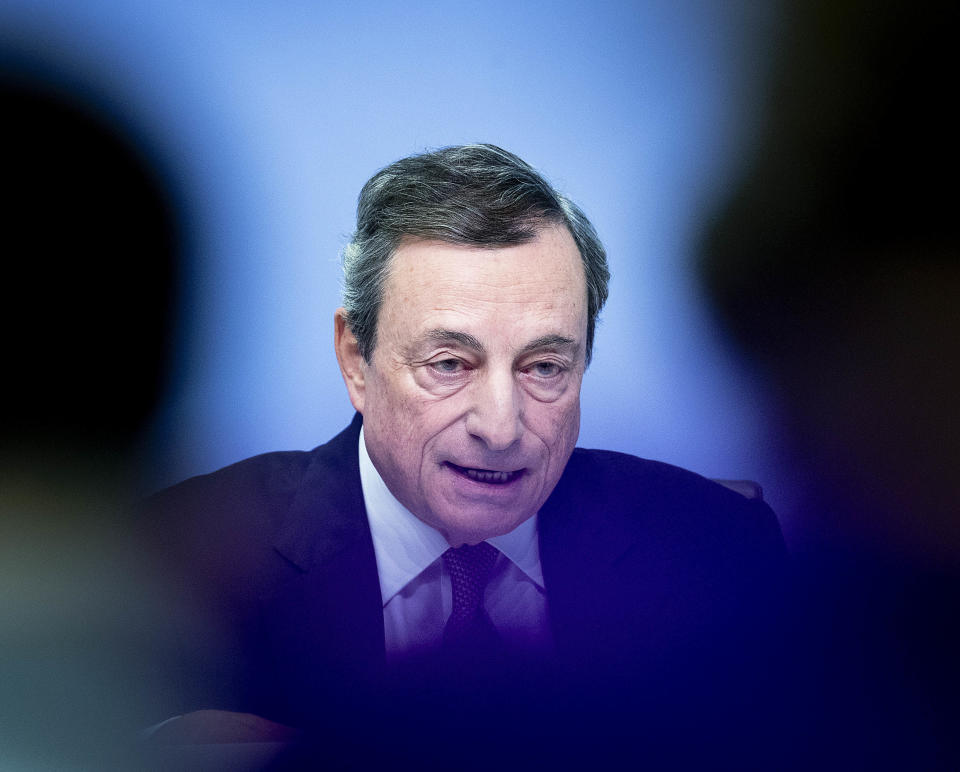ECB leaves interest rates unchanged in Mario Draghi's final act

The European Central Bank on Thursday left interest rates unchanged just weeks after it unveiled a sweeping stimulus package designed to lift the eurozone’s flagging economy.
Mario Draghi, who will cede the presidency of the bank to Christine Lagarde on 1 November, concluded his term by warning of “protracted weakness” and “prominent downside risks” in the region.
The governing council said on Tuesday that it expected interest rates to “remain at their present or lower levels” until inflation in the eurozone, which has remained stubbornly below target, picked up.
It was something of a muted finale for Mario Draghi, whose eight years in the role have been characterised by a remarkable steadiness. But he will also leave an unusually divided governing council in his wake.
“It is becoming quite clear that there are growing tensions within the governing council over the direction of monetary policy,” said Michael Hewson, the chief market analyst at CMC Markets.
READ MORE: European factories axe jobs in worst round of cuts since 2013
Last month, the council voted to cut one of its key interest rates for the first time since early 2016, pushing it into record negative territory.
The bank also revived its controversial quantitative easing programme, saying it would purchase €20bn (£17bn) in assets each month “for as long as necessary”, starting in November.
Central bankers from the Netherlands, Germany, and Austria publicly questioned the rationale for the moves, while a German member of the bank’s executive board, Sabine Lautenschläger, resigned in apparent protest of the plan.
“These tensions are only likely to increase when Christine Lagarde takes over on 1 November,” Hewson said.
But Draghi is more than used to mayhem. Mere months after he took office in 2011, he was faced with the ballooning Greek debt crisis.
While the bank was torn between keeping the country’s banks afloat and obeying its own stringent rules, Draghi was insistent that if anyone was going to push Greece out of the euro, it would not be the ECB.
In July 2012, as tensions about the country reached an acrimonious pitch, Draghi told a London audience of investors that the bank was prepared to do “whatever it takes to preserve the euro.”
The vow almost immediately calmed financial markets, and was later seen as a turning point in the eurozone crisis, which had spread to countries like Italy.
READ MORE: 85,000 jobs lost on UK high streets in a year
Draghi’s skilled advocacy and telegenic presence at press conferences was underpinned by an exceptional understanding of monetary policy. A former governor of the Italian central bank, Draghi completed his PhD thesis on economic theory at MIT, where he studied under Nobel prize winner Franco Modigliani.
His training gave him the confidence to expand the ECB’s arsenal with never-before-used monetary policy tools, such as negative interest rates and cheap long-term loans to banks.
Untouched by old illusions, in 2014 Draghi announced that the bank would begin buying assets from banks in order to encourage lending, before controversially expanding the programme to include government bonds several months later.
Described by Paul Krugman as arguably the greatest central banker of modern times, Draghi is thus credited with pulling the euro back from the brink — and lifting the region’s economy at a time when governments had been unalterably opposed to spending the cash required to do so.
But economic data and price growth in the eurozone have lagged in recent months, prompting Draghi to step up his attempts to convince national governments to stimulate their economies with things like infrastructure spending.
“All countries should intensify their efforts to achieve a more growth-friendly composition of public finances,” Draghi said on Thursday.
“This meeting may be Draghi’s swansong, and he certainly leaves the euro in a much more stable position than he found it, but the European economy still remains extremely vulnerable,” said Hewson.

 Yahoo Finance
Yahoo Finance 
